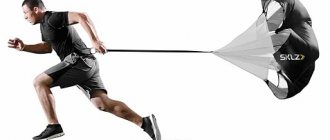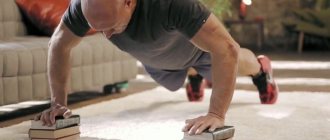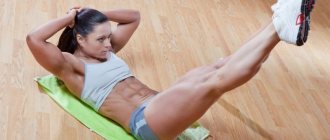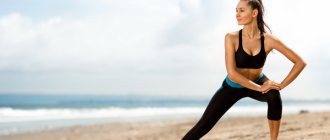Everything you need to know about how to build strength and endurance through running.
This is the third and final part of a three-part series (here's the first and second) on how to build strength, endurance, and burn fat through running. Today we’ll figure out how to eat properly when running, what sports supplements to take, and what running does if you’re already training with weights.
What is raking and what are its benefits?
It's simple. You take a backpack, put weights in it and leave the house for a walk. Of course, racking has its own subtleties, more on that below, but essentially it’s just walking with a load located behind your back.
Compared to regular walking, walking with a backpack has advantages:
Rucking improves posture and gives muscles a natural load
If you sit at a computer all day in the office or at home, your body is under serious strain. The vertebrae are compressed, which leads to deterioration of blood supply and pain, some muscles are overextended, others, on the contrary, are switched off from their natural rhythm. All this leads to discomfort and contributes to the occurrence of various diseases.
While walking slowly with a backpack, all your muscles are actively working, including the most important one - the heart. You have to keep your back straight (which brings the vertebrae into their normal position) and engage the muscles that fix your back.
There is an opinion that carrying loads on the back is harmful to the health of the lower back and creates unnecessary stress on the knees. This is true, but with the right approach you can reduce the risk of injury to zero. We'll talk about this a little further.
Rucking promotes weight loss
In addition to strengthening your abdominal muscles, walking with a backpack also burns a hell of a lot of calories—several times more than regular walking. During a half-hour walk at a speed of 5-6 km/h, a 60-kilogram person will burn 80-100 kcal. Multiply by 3, we get 240-300 kcal. A person will burn about the same amount in half an hour of continuous running or swimming. It's quite tempting for a backpacking trip, isn't it?
Racing is a convenient form of cardio
If we continue to compare rucking with other types of cardio exercises (and rucking is cardio and in no case a strength exercise), then it is worth saying that rucking is simple, discreet and safe.
- If you are overweight, then, most likely, long-distance running will be contraindicated for you, but after a short period of adaptation, you will be able to walk with a backpack for quite a long time and far.
- You don't have to buy any special equipment other than a backpack and normal sneakers.
- You will fit into any landscape - unlike a person, for example, with Nordic walking poles.
- Rucking can, to some extent, be integrated into other daily activities. Need to go to the post office or to the store? We put on our backpack and went.
- And finally, racking, in principle, assumes that you will walk outside, in the fresh air - and walking in the fresh air, with or without a backpack, is good for both the brain and the body.
Contraindications
Weights put a more powerful load on the body, so there are a number of cases when they cannot be used. Contraindications are:
- problems with veins and varicose veins;
- disturbances in the functioning of the heart and blood vessels;
- vision problems;
- urolithiasis disease;
- fractures, dislocations and sprains, recent surgeries;
- high pressure;
- diseases of the joints and spine.
We recommend reading about strength exercises at home. From the article you will learn about the effectiveness of strength training, the necessary attributes for performing exercises, and a complex for weight loss. And here is more information about exercises with a barbell for weight loss.
Weights promote more effective weight loss. The right equipment will make even the simplest exercises more effective. The muscles will become more elastic and developed. But it is important not to overdo it and harm yourself. Therefore, you should perform your workouts carefully, listening to your feelings.
Rucking technique
To get started, you only need two things: any simple backpack and the weight you put in it. All.
As weight, you can use any heavy things of more or less regular shape that will not dig into your back. These could be, for example, bags of sand, containers of water (make sure the water is not splashing), bricks wrapped in fabric, or weight plates.
It is very important that the load rests against your back and does not dangle below, destabilizing the spine. Adjust the straps and try to secure the load as high as possible so that the load falls on the shoulders and upper back muscles. Remember, we don't want stress on the lower back.
For the sake of experiment, you can walk 5 km with a load in the upper part and 5 km with a load in the lumbar region - the sensations will be different, and in the second case you will definitely not like them.
As for clothes and shoes, for short distances (up to 10 km) it does not matter what you wear. The recommendations here are the same as for walking - you should be comfortable, your body can breathe and your sneakers should not rub.
When you are ready to walk with heavier weights over long distances, it makes sense to upgrade your equipment.
https://youtu.be/PmwwNXn-tvE
Benefits of running with weights
The benefits of training with weights depend on the type of activity and goals of the athlete:
- Increasing endurance when preparing for a marathon, doing extreme sports such as skyrunning and overcoming long distances in the mountains
- Increased leg strength (the so-called “explosive effect”) when running obstacles or hurdles, as well as long and high jumps
- Reducing the duration of your workout while maintaining its intensity
- Growth of bone cells as a result of increasing stress on the skeleton
- Strengthening the cardiovascular system (in the absence of chronic diseases)
- Accelerated burning of excess calories
- Uniform pumping of muscles throughout the body and improvement of muscle relief
How to choose a backpack and shoes for long hikes?
In our country, at the time of writing, special backpacks for raking are not yet sold, so we will select a backpack in ordinary sports or travel stores. For one-day excursions, a regular city backpack with a capacity of 20+ liters will do, in which, in addition to cargo, you can put food, a change of clothes and everything you need. For hikes of 2 days or more, look for backpacks that are 40 liters or more (depending on what you'll be taking with you).
When writing this article, I did not set out to talk about how to choose a backpack for tourism in general, so I will limit myself to only a few points regarding the specifics of backpacking.
You will need a backpack containing:
- Possibility of adjusting the back of the backpack according to height
- Comfortable straps – soft, not too narrow and not too wide
- Chest strap is adjustable in height and length to prevent the straps from sliding down.
- A waist belt that takes some of the weight off your shoulders and spine, with a comfortable, easy-to-unfasten buckle. A lumbar pad that performs the same functions would also be useful.
It’s convenient if there is room in your backpack for a hydraulic system - this is a thing that helps you drink water without removing your backpack.
In second place after choosing a backpack for a long hike is the choice of shoes.
Soft, flexible running shoes with good cushioning and a wide segmented sole are good for walking on asphalt. It is important that the sneakers are light - on long hikes, every extra gram of weight leads to unnecessary waste of energy.
For walking on rough terrain, you will need more durable running shoes. The best option for not too hot weather is trail crosses. As a rule, their soles are studded, the heel and toe are protected from impacts with rubber pads, and the ankle is better protected from dislocation. This is the only way to protect your feet from minor troubles in the form of sticks or stones. The upper part of the sneakers is made of water-resistant materials. Sneakers for country walking are heavier than city shoes, but in any case lighter than hiking shoes designed for multi-day hikes.
No matter what sneakers you buy, make sure they fit well on your feet. A small chafing that you don't notice can turn into a bloody callus in a few hours, and you simply won't be able to walk. Carrying a backpack on your shoulders increases the stress on your feet and increases the likelihood of blisters. So don't be surprised if you have to try several pairs before you find the right shoe for your feet.
How to train?
Any good training plan requires you to gradually increase weights and distances and exercise regularly. Don’t try to immediately run a half marathon with a 20-kilogram backpack - this is fraught with problems, even if you are quite physically prepared.
If you want to get the most out of rucking, then do it a little, but every day or every other day. It’s not difficult to set aside half an hour a day, and, as I wrote above, rucking can easily be integrated into everyday activities. By putting in the time in the beginning, you will gradually discover that you have become an amazingly fast and resilient person.
Important note!
Make sure that raking does not turn from aerobic cardio into an anaerobic strength exercise - perhaps this will help in the development of the muscles of the back and lower back, but it can lead to injury and will nullify the fat-burning and general strengthening effect. What I mean is that if it’s really hard and painful for you to carry the load, then think about it - perhaps you overdid it with the load. If you have a heart rate monitor, make sure that your heart rate does not go beyond the aerobic zone. If not, then use a simple indicator - when approaching the anaerobic zone, it becomes difficult for you to speak while walking due to the fact that your breathing becomes difficult.
And one more tip - never run with a backpack in your training, unless you are in the army or you are not a pro at running with a backpack. Take care of your back and joints.
Take care of your back and joints.
The initial weight in the backpack is 5 kg. The initial distance is 5 km. Exercise regularly and increase the load and distance by no more than 10% per week. The following test can be used as control points: walk at a speed of 5-6 km/h with a backpack for a long time (half an hour, an hour). If it works, it means that the body accepts the load normally, and you can begin to increase it.
Once you get used to it, here are a few more checkpoints:
- walk 5 km with 20 kg in less than 40 minutes
- walk 10 km with 20 kg in less than 1.5 hours
- walk 30 km with 20 kg in less than 5 hours
After each workout, be sure to stretch your back and shoulders for a few minutes.
Why do you need to run with weights?
In 2002, scientists at Texas Tech University conducted a series of studies aimed at determining the effectiveness of weighting materials. The subject of the research was a local football team. For 6 weeks, the players performed traditional exercises to develop endurance and explosiveness. At the same time, part of the team used weight vests.
Having compared the results of both groups, scientists made a clear conclusion. The entire team improved their performance in the long and high jumps, as well as in the sprint run to 36.5 meters. However, the performance of the group that trained with weights increased significantly compared to the second group of players.
Increasing your own weight with weights makes you put more effort into running. As a result:
- Ligaments and tendons are strengthened
- Muscle mass increases
- Increases the force of the push when jumping
- Increases body endurance
- More calories burned
Research from the American Council on Exercise supports the use of lightweight weights. For example, running with 0.5-1 kg arm cuffs or 0.7-1.3 kg leg cuffs increases your heart rate by at least 10 beats per minute. At the same time, the level of oxygen consumption increases by 5-15%. This has a positive effect on the cardiovascular and respiratory systems.











